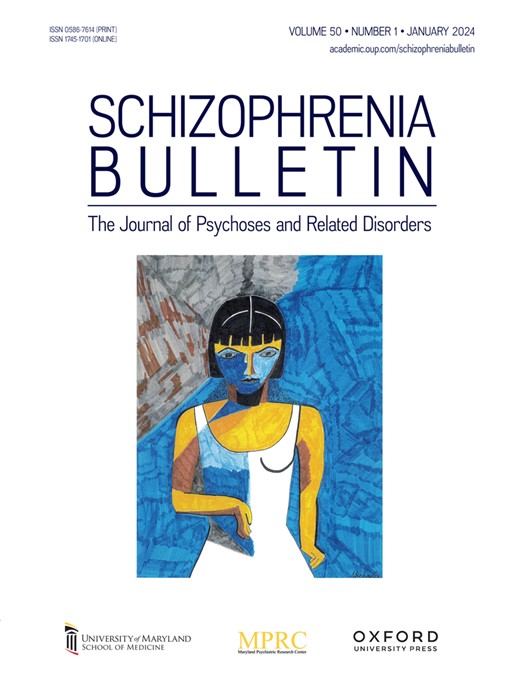Fronto-Thalamic Structural Connectivity Associated With Schizotypy, a Psychosis Risk Phenotype, in Nonclinical Subjects
IF 5.3
1区 医学
Q1 PSYCHIATRY
引用次数: 0
Abstract
Background and Hypothesis Schizotypy is a risk phenotype for the psychosis spectrum and pilot studies suggest a biological continuum underlying this phenotype across health and disease. It is unclear whether this biological continuum might include brain structural associations in networks altered in schizophrenia spectrum disorders, such as the fronto-thalamo-striatal system or nodes of the default mode network, such as the precuneus. Study Design In this study, we analyze a large multi-center cohort of 673 nonclinical subjects phenotyped for schizotypal traits (using the Schizotypal Personality Questionnaire-Brief version) using tract-based spatial statistics of diffusion tensor imaging data, as well as voxel-based morphometry (VBM) analysis of regional brain volumes and gyrification analysis of early neurodevelopmental markers of cortical folding on T1-weighted MRI. Study Results We identify significant (P < .05 family-wise error corrected) associations of schizotypy with major fiber tract fractional anisotropy: positive (cognitive-perceptual) schizotypy correlated negatively with the left anterior thalamic radiation (a principal thalamo-frontal projection), left uncinate fasciculus and cingulum, while negative (interpersonal) schizotypy correlated positively with left anterior thalamic radiation, cingulum, and the anterior corpus callosum, and disorganized schizotypy correlated negatively with right cingulum, and superior and inferior longitudinal fasciculi. VBM analyses showed a negative correlation of gray matter with negative schizotypy in the left cerebellum, while gyrification in the inferior parietal cortex correlated positively with negative (interpersonal) schizotypy. Conclusions These findings pave the way for a neural network conceptualization of schizotypy as a psychosis proneness trait across the general population, showing associations with fronto-subcortical and frontotemporal systems as structural substrates of this risk phenotype.在非临床受试者中,与精神分裂型相关的额丘脑结构连通性是一种精神病风险表型
背景和假设精神分裂型是精神病谱系的一种风险表型,初步研究表明,这种表型在健康和疾病之间存在生物学连续性。目前尚不清楚这种生物连续体是否包括精神分裂症谱系障碍中改变的网络中的大脑结构关联,如额丘脑纹状体系统或默认模式网络的节点,如楔前叶。在这项研究中,我们分析了一个由673名非临床受试者组成的大型多中心队列(使用分裂型人格问卷-简要版),使用基于束的扩散张量成像数据的空间统计,以及基于体素的区域脑容量形态测定(VBM)分析和t1加权MRI上皮层折叠早期神经发育标记的旋转分析。研究结果:我们发现了显著的(P <;(0.05家庭误差校正)分裂型与主要纤维束分数各向异性的关联:阳性(认知-知觉)分裂型与左丘脑前辐射(主要的丘脑额叶投射)、左钩扣束和扣带呈负相关,阴性(人际)分裂型与左丘脑前辐射、扣带和前胼胝体呈正相关,无序分裂型与右侧扣带、上下纵束束呈负相关。VBM分析显示,左侧小脑灰质与负分裂型呈负相关,而下顶叶皮层的回转与负(人际)分裂型呈正相关。这些发现为将精神分裂型的神经网络概念化为一种普遍人群的精神病倾向特征铺平了道路,显示了与额皮质下和额颞叶系统作为这种风险表型的结构基础的关联。
本文章由计算机程序翻译,如有差异,请以英文原文为准。
求助全文
约1分钟内获得全文
求助全文
来源期刊

Schizophrenia Bulletin
医学-精神病学
CiteScore
11.40
自引率
6.10%
发文量
163
审稿时长
4-8 weeks
期刊介绍:
Schizophrenia Bulletin seeks to review recent developments and empirically based hypotheses regarding the etiology and treatment of schizophrenia. We view the field as broad and deep, and will publish new knowledge ranging from the molecular basis to social and cultural factors. We will give new emphasis to translational reports which simultaneously highlight basic neurobiological mechanisms and clinical manifestations. Some of the Bulletin content is invited as special features or manuscripts organized as a theme by special guest editors. Most pages of the Bulletin are devoted to unsolicited manuscripts of high quality that report original data or where we can provide a special venue for a major study or workshop report. Supplement issues are sometimes provided for manuscripts reporting from a recent conference.
 求助内容:
求助内容: 应助结果提醒方式:
应助结果提醒方式:


